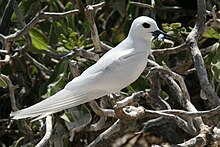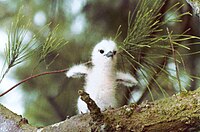White tern
| White tern | |
|---|---|

| |
| A white tern on the French Frigate Shoals | |
| Scientific classification | |
| Domain: | Eukaryota |
| Kingdom: | Animalia |
| Phylum: | Chordata |
| Class: | Aves |
| Order: | Charadriiformes |
| Family: | Laridae |
| Genus: | Gygis |
| Species: | G. alba
|
| Binomial name | |
| Gygis alba (Sparrman, 1786)
| |

| |
The white tern or common white tern (Gygis alba) is a small
Taxonomy
The white tern was first formally described by the Swedish naturalist Anders Sparrman in 1786 under the binomial name Sterna alba.[4] The genus Gygis was introduced by the German zoologist Johann Georg Wagler in 1832.[5] The name Gygis is from the Ancient Greek guges for a mythical bird and the specific alba is Latin for "white".[6]
The white tern has the following recognized subspecies:
- G. a. alba, (Trindade, Martin Vas Rocks, Ascension and St. Helenaislands
- G. a. candida, (Gmelin, 1789):[10] Seychelles & Mascarene Islands to central Pacific including southern Maldives excluding range of G. a. leucopes and Gygis microrhyncha
- G. a. leucopes, Holyoak & Thibault, 1976:[11] Pitcairn Islands
Some authors have postulated that there may be three species of Gygis: Gygis alba, in the Atlantic Ocean, and Gygis candida and Gygis microrhyncha, both in the Pacific.[12]
Description
The white tern has a wingspan of 76–87 cm (30–34 in).[13] It has white plumage and a long black bill.[14] Nesting on coral islands, usually on trees with small branches but also on rocky ledges and on man-made structures, the white tern feeds on small fish which it catches by plunge diving. Giant tortoises have been observed to hunt the bird on Fregate Island in the Seychelles.[15]
Distribution and habitat
The white tern ranges widely across the Pacific Ocean from the coasts of Chile and Colombia to New Zealand and along the eastern and southern coasts of Asia from China to India, South Maldives, the islands of the Indian Ocean, and the coast of South Africa.
-
Fairy or white tern baby, Midway Island
-
White tern parents near their chick, in Cousin Island, Seychelles.
-
Gygis alba -MHNT
Behavior
This species is notable for laying its
Relationship with humans
The white tern, manu-o-Kū, was named
New Zealand's Department of Conservation classifies the white tern as Nationally Critical, with populations having been largely decimated by the introduction of feral cats and rats on Raoul Island, the terns' only breeding site in the country.[18] As of 2016, the white tern population in New Zealand was reported to be increasing following the eradication of introduced predators in 2002.[18][19] Globally, the white tern has a large range that is home to several large colonies, and both recognised species are listed as Least Concern by the IUCN Red List.
References
- ^ . Retrieved 12 November 2021.
- ^ "Common White Tern (Gygis alba) - BirdLife species factsheet". datazone.birdlife.org. Retrieved 2021-05-04.
- ^ del Hoyo, J; Collar, N.J.; Christie, D.A.; Elliott, A.; Fishpool, L.D.C. (2014). HBW and BirdLife International Illustrated Checklist of the Birds of the World. Volume 1: Non-passerines. Barcelona, Spain and Cambridge, UK.: Lynx Edicions BirdLife International.
- ^ Sparrman, Anders (1786–1789). Museum Carlsonianum, in quo novas et selectas aves, coloribus ad vivum brevique descriptiones illustratas (in Latin). Vol. fasc. 1. Holmiae: Ex Typographia Regia. Plate 11.
- ^ Wagler, Johann Georg (1832). "Neue Cippen und Gattugen der Caugthiere und Vögel". Isis von Oken (in German and Latin). Column 1223.
- ISBN 978-1-4081-2501-4.
- .
- ^ Gill, Frank; Donsker, David, eds. (2019). "Noddies, gulls, terns, auks". World Bird List Version 9.2. International Ornithologists' Union. Retrieved 24 June 2019.
- ^ "Gygis alba alba (Common White-Tern (Atlantic)) - Avibase". avibase.bsc-eoc.org. Retrieved 2021-05-04.
- ^ "Gygis alba candida (Common White-Tern (Pacific)) - Avibase". avibase.bsc-eoc.org. Retrieved 2021-05-04.
- ^ "Gygis alba leucopes (Common White-Tern (leucopes)) - Avibase". avibase.bsc-eoc.org. Retrieved 2021-05-04.
- .
- ^ Gochfeld, M.; Burger, J.; Christie, D.A.; Kirwan, G.M. "Common White Tern (Gygis alba)". In del Hoyo, J.; Elliott, A.; Sargatal, J.; Christie, D.A.; de Juana, E. (eds.). Handbook of the Birds of the World Alive. Lynx Edicions. Retrieved 16 April 2017.
- doi:10.2173/bna.371
- PMID 34428417.
- .
- ^ Hawaii’s Comprehensive Wildlife Conservation Strategy October 1, 2005
- ^ )
- )
Further reading
- Yeung, N.W.; Carlon, D.B.; Conant, S. (2009). "Testing subspecies hypothesis with molecular markers and morphometrics in the Pacific white tern complex". Biological Journal of the Linnean Society. 98 (3): 586–595. .
External links
- White tern videos, photos & sounds on the Internet Bird Collection




